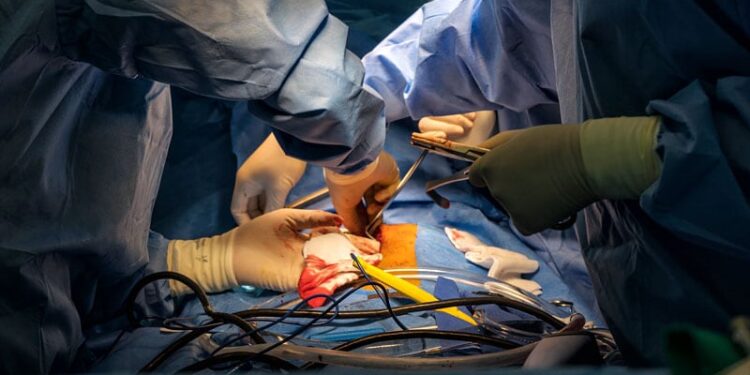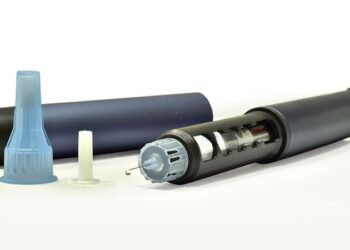CHICAGO — Five years after treatment, patients with severe aortic stenosis had comparable rates of all-cause mortality or disabling stroke, whether they received transcatheter aortic valve replacement (TAVR) or surgery, according to midterm results from the Evolut Low Risk trial.
The randomized, multicenter, international study compared the safety and efficacy of the Evolut TAVR system with surgery in patients with a low — less than 3% — 30-day mortality risk. The results were presented by principal investigator Michael J. Reardon, MD, professor of cardiothoracic surgery at the Houston Methodist Hospital, Texas, during a late-breaker here at the American College of Cardiology (ACC) Scientific Session 2025, and published simultaneously in the Journal of the American College of Cardiology.
Of the 1414 patients, 730 received TAVR and 684 underwent surgery. Mean age was 73 years, and 35% of patients were women. The trial was sponsored by Medtronic, the manufacturer of the Evolut system.
At 5 years, the Kaplan-Meier estimate for the primary endpoint of all-cause mortality or disabling stroke was 15.5% in the TAVR group and16.4% in the surgery group (P = .47).
Endpoint Comparable at All Timepoints
“For every time point across 5 years, TAVR has done as well as surgery for the primary endpoint,” said Reardon.
Estimates in the TAVR and surgery groups for all-cause mortality were 13.5% and 14.9% (P = .39) and for disabling stroke were 3.6% and 4.0% (P = .57).
Cardiovascular mortality was 7.2% in the TAVR group and 9.3% in the surgery group (difference, 2.1%; 95% CI, 5.3%-1.1%; P = .15). The noncardiovascular death rate in the TAVR and surgery groups was 6.8% and 6.2%, respectively (difference, 0.6%; 95% CI, 2.3%-3.5%; P = .73).
By the 5-year mark, 3.3% of patients in the TAVR group and 2.5% of patients in the surgery group had undergone aortic valve reintervention (difference, 0.8%; 95% CI, 1.2%-2.9%; P = .44). When reintervention was necessary, aortic regurgitation — valvular or paravalvular — stenosis, and endocarditis were the primary indications.
No Data on Patients Younger Than 65
“Anyone similar to the population we tested can rely on these data,” said Reardon, who cautioned that the data do not apply to patients younger than 65 years. “One of my worries as a cardiac surgeon is that, across the country, we see this almost irrational exuberance in moving to younger patients without any data.”
A 2022 randomized trial and others have demonstrated excellent short-term outcomes in low-risk patients, but longer-term data for supra-annular self-expanding valves are limited.
One of the main advantages of TAVR is time to recovery. “If I do a TAVR on you, you generally go home the next day, and by the end of 1 week, you’re back to completely normal activity.” Reardon reported. With surgery, however, “the average stay is 5 to 7 days and it’s 2 months before I let you lift anything really heavy.”
Surgery Will Remain, Become More Complex
Surgery’s not going away, but will be more complex. “For sites with a really good surgeon, that surgeon’s going to be worth their weight in gold,” he said.
Although the data look good at 5 years, “as a surgeon, I’ll tell you we need to get to 10 years before we really know how valves perform,” he explained. The goal of his team is to publish data from the trial every year up to 10 years.
“It’s good to see that the surgical data compare to the TAVR data,” because the less-invasive procedure is preferred for appropriate patients, said Jasmina Katinic, DNP, APRN, director of the Structural Heart Program for the West Florida Division of HCA Healthcare, and chair of the ACC Structural Heart Workgroup, during the news conference.
“What is actually excellent to see is that the patients also feel better in a 5-year period,” she added.
The researchers found sustained improvement in quality of life in both treatment groups. The average Kansas City Cardiomyopathy Questionnaire (KCCQ) summary scores in the TAVR and surgery groups were similar (88.3 vs 88.5). And about 70% of patients in both groups met the criteria for being alive and well (a KCCQ summary score greater than 75).
“We have to use the shared decision-making process with the patient to help them understand not only their procedural outcomes, but the longevity of some of the procedures we offer to them,” Katinic said.
The study was funded by Medtronic. Reardon has received research grants from Abbott, Boston Scientific, WL Gore Medical, and Medtronic. Full disclosures for the other authors are available in the publication. Katinic reported no relevant financial relationships.
Source link : https://www.medscape.com/viewarticle/5-year-tavr-surgery-outcomes-similar-low-risk-patients-2025a10007zl?src=rss
Author :
Publish date : 2025-04-02 20:55:00
Copyright for syndicated content belongs to the linked Source.














